
Castletown is a town in the Isle of Man, geographically within the historical parish of Malew but administered separately. Lying at the south of the island, it was the Manx capital until 1869. The centre of town is dominated by Castle Rushen, a well-preserved medieval castle, originally built for a Viking king.

Port Erin is a seaside village in the south-west of the Isle of Man, in the historic parish of Rushen. It was previously a seaside resort before the decline of the tourist trade. Administratively it is designated as a village district, with its own board of commissioners. The district covers around 1 square mile, and is adjacent to: Port St Mary to the south-east; the main part of Rushen parish district to the north and east; the sea to the west; and an exclave of Rushen parish district to the south. Following recent residential expansion, the settlement is now contiguous with that of Port St Mary, and on 18 July 2018 Tynwald authorised a public enquiry into the proposed expansion of the district boundary to include some of this expansion.
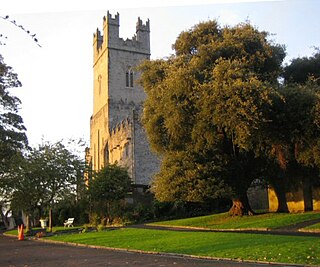
Saint Mary's Cathedral, Limerick, is a cathedral of the Church of Ireland in Limerick, Ireland, which is dedicated to the Blessed Virgin Mary. It is in the ecclesiastical province of Dublin. Previously the cathedral of the Diocese of Limerick, Ardfert and Aghadoe, it is now the central cathedral in the United Dioceses of Limerick and Killaloe.

The Cathedral Church of Saint German or Peel Cathedral, rebranded as Cathedral Isle of Man, is located in Peel, Isle of Man. The cathedral is also one of the parish churches in the parish of the West Coast, which includes the town of Peel, and was built in 1879–84. It was made the cathedral by Act of Tynwald in 1980.

Ballabeg is a village on the Isle of Man. It is in the parish of Arbory in the sheading of Rushen, in the south of the island near Castletown. There are several small villages and hamlets with the name, although Ballabeg in Arbory is the most well-known and populous.

Saint-Étienne-du-Mont is a church in Paris, France, on the Montagne Sainte-Geneviève in the 5th arrondissement, near the Panthéon. It contains the shrine of St. Geneviève, the patron saint of Paris. The church also contains the tombs of Blaise Pascal and Jean Racine. Jean-Paul Marat is buried in the church's cemetery.
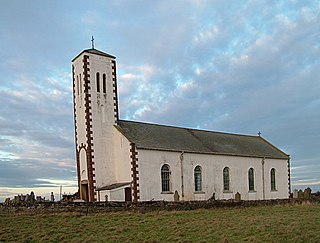
Jurby is one of the seventeen parishes of the Isle of Man. It is located in the north-west of the island in the sheading of Michael.
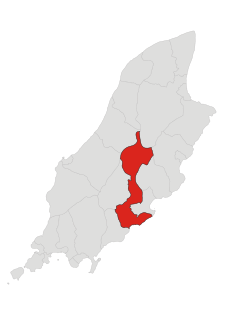
Braddan is one of the seventeen parishes of the Isle of Man.

Newbattle is a village and civil parish in Midlothian, in the ancient Roman Catholic Diocese of St. Andrews, about seven miles from Edinburgh. There was an abbey there founded about 1140, being the second of the six Cistercian Monasteries established by King David I of Scotland.

Llangelynnin is a former parish in the Conwy valley, in Conwy county borough, north Wales. Today the name exists only in connection with the church, a school in the nearby village of Henryd, and the nearby mountain ridge, Craig Celynnin.

Crosby is a small village located 3.7 mi (6.0 km) west of Douglas in the parish of Marown in the Isle of Man.

Glen Vine is a small village on the Isle of Man in the parish of Marown. The village is also a point on the Isle of Man TT course.
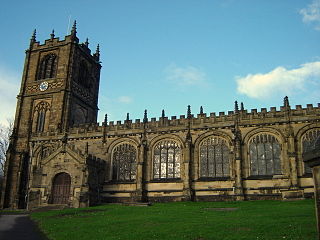
St Mary's Church is an Anglican parish church in Mold, Flintshire, Wales, and a Grade I listed building. It belongs to the Deanery of Mold, the Archdeaconry of Wrexham and the Diocese of St Asaph of the Church in Wales. It has historical associations with the Stanley family, Earls of Derby and displays heraldic symbols of this, including an Eagle and Child assumed by the family in the 15th century, and the Three Legs of Man, derived from a time when the Stanleys were Lords of Mann. Under Father Rex Matthias, the previous incumbent, the church took on an Anglo-Catholic style of liturgy.
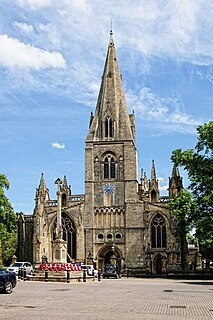
St Denys' Church is a medieval Anglican parish church in Sleaford, Lincolnshire, England. While a church and a priest have probably been present in the settlement since approximately 1086, the oldest parts of the present building are the tower and spire, which date to the late 12th and early 13th centuries; the stone broach spire is one of the earliest examples of its kind in England. The Decorated Gothic nave, aisles and north transept were built in the 14th century. The church was altered in the 19th century: the north aisle was rebuilt by the local builders Kirk and Parry in 1853 and the tower and spire were largely rebuilt in 1884 after being struck by lightning. St Denys' remains an active parish church.

The Parish Church of All Saints' Lawshall, is an Anglican church in the village of Lawshall, Suffolk, England. It has been designated by English Heritage as a Grade I listed building. The church is located in between Lawshall Hall and All Saints CEVCP Primary School. The church is part of the St Edmund Way Benefice, whose Rector is Revd Jeremy Parsons.
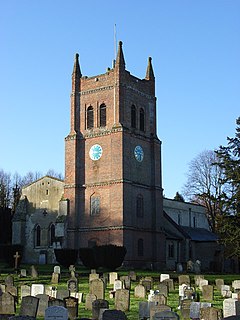
All Saints Church is an Anglican parish church in the village of Crondall, Hampshire, England. It is a Grade I listed building and stands at the highest point in the village. Much of the church dates from the Norman period, although the original central tower was replaced by a brick one at the north-east corner in 1659 and some alterations, particularly to the fenestration, the nave arcades and transepts, and the north porch, were made in two stages during the 19th century.

All Saints Church, Douglas, Isle of Man, is a 1967 Modernist Anglican church which closed in May 2017.

St Trinian's Church is the roofless ruin of a small chapel at the foot of Greeba Mountain, adjacent to the main A1 Douglas - Peel Road in the parish of Marown, Isle of Man. Referred to in the Manx language as a "Keeil Brisht", the church is the source of an ancient Manx folktale concerning the Buggane, a huge mythical ogre who lived on Greeba Mountain and who vowed that the church should never be completed.

St Rufus Church, also known as Keith Parish Church, is a Church of Scotland church in Keith, Moray, that was built in 1816. Designed by James Gillespie Graham in the Perpendicular Gothic style, it has crenellated walls, traceried windows and a tall bell and clock tower at its west end. The doorway leading into the nave from the entrance lobby is an unusual war memorial, listing the names of parishioners who died in the First World War on one side, and in the Second World War on the other.



























